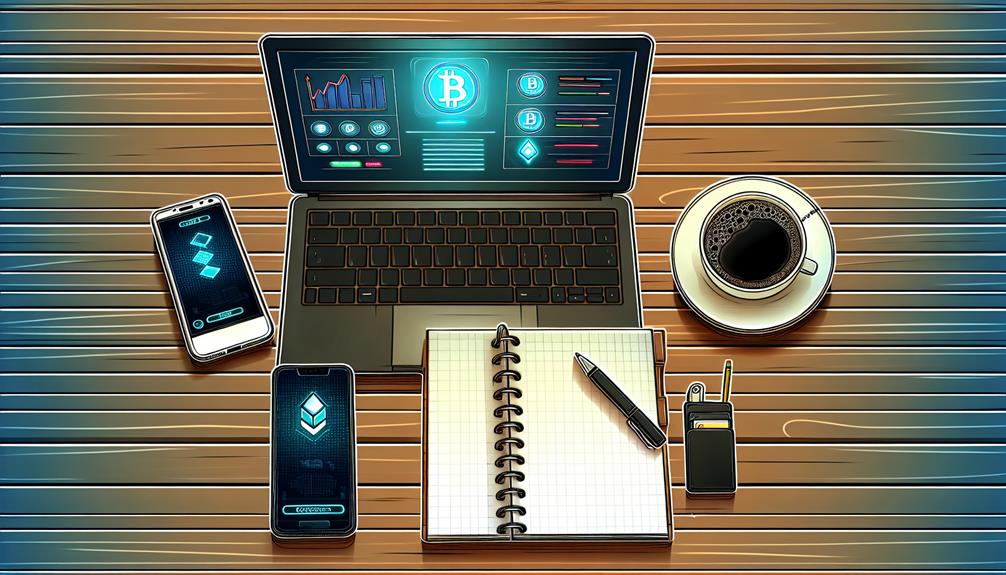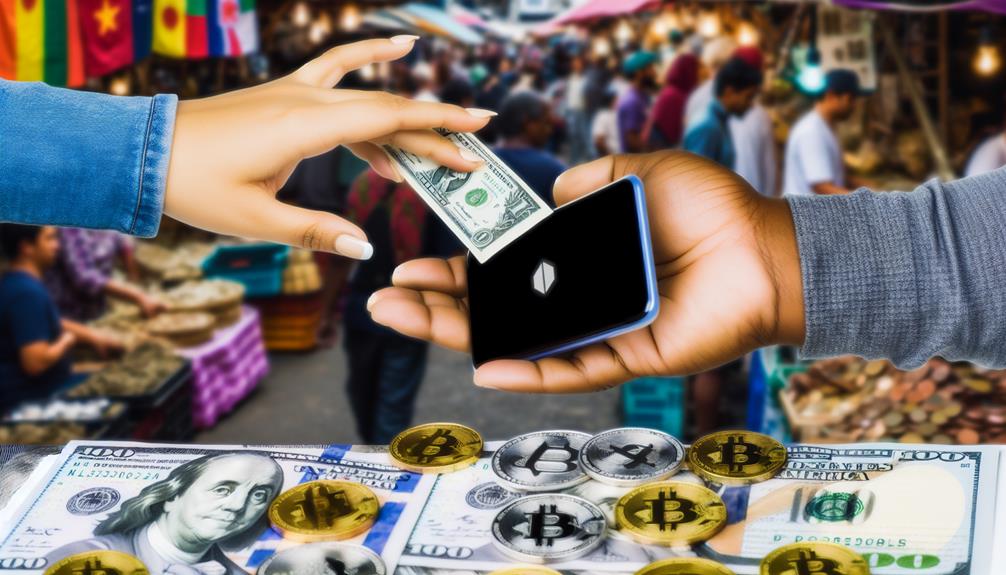When you're looking to sell crypto for cash, the process can seem intimidating at first. You'll need to choose a reliable platform that fits your needs, set up your account, and understand the potential pitfalls, including transaction fees and tax implications. Each step requires careful consideration to guarantee a smooth transaction. But what happens after you've sold your crypto? How do you securely manage the cash you receive, and what should you keep in mind to avoid common mistakes? These details can greatly impact your experience.
Understanding Cryptocurrency Basics

Diving into the world of cryptocurrency can be overwhelming, especially if you're new to the concept. To grasp the basics, it's essential to understand blockchain fundamentals. At its core, blockchain is a decentralized ledger technology that records transactions across many computers securely. This means no single entity governs it, which enhances transparency and trust. Each block in the chain contains a number of transactions, and once a block is filled, it's added to the chain in a linear, chronological order. This structure makes it nearly impossible to alter past transactions, establishing a layer of security.
Once you grasp blockchain fundamentals, you'll need to familiarize yourself with crypto wallets. These digital wallets are vital for storing, sending, and receiving cryptocurrencies. There are two main types: hot wallets and cold wallets. Hot wallets are connected to the internet and offer convenience for frequent trading. However, they're more vulnerable to hacks. On the other hand, cold wallets are offline storage devices, providing enhanced security for long-term holdings.
Understanding these basics will lay a solid foundation for your journey into the cryptocurrency market. As you navigate through buying, trading, and eventually selling crypto for cash, knowing how blockchain and wallets work will empower you to make informed decisions. Clarity on these concepts helps demystify the complexities of cryptocurrency, making it easier to engage confidently in this digital economy.
Choosing the Right Platform
When you're ready to sell your crypto for cash, choosing the right platform is essential. You'll need to decide between using an exchange or a peer-to-peer service, as each has its own advantages and drawbacks. Additionally, pay attention to fees and limits that could impact your overall transaction experience.
Exchange Vs. Peer-To-Peer
Choosing the right platform to sell your crypto can greatly impact your overall experience and profitability. When considering exchanges, you'll find several advantages, such as high liquidity levels, allowing for quicker transactions and better prices, particularly during market volatility. These platforms often offer a variety of payment methods, enhancing your flexibility. However, keep in mind the security considerations; while exchanges typically have robust measures, they can be targets for fraud.
On the other hand, peer-to-peer (P2P) platforms provide unique benefits, like direct transactions with buyers or sellers, which can lead to better deals. They usually offer enhanced user experience, as you can negotiate terms directly. However, P2P transactions come with increased fraud risks, so you need to exercise caution. Regulatory compliance varies between exchanges and P2P platforms, so make sure you're aware of the rules that apply to your chosen method.
Fees and Limits
Understanding the fees and limits associated with selling crypto is vital for maximizing your returns. Different platforms have varying transaction costs that can greatly impact your overall profit. Exchange fees can include trading fees, which are charged for executing your buy or sell orders, and security fees, which cover the costs of securing your assets.
You'll also want to take into account network fees, which are required for processing transactions on the blockchain. These can fluctuate based on market demand, so timing your sales can help reduce costs. Additionally, withdrawal limits may apply, affecting how much cash you can access at once. If you frequently need to withdraw large sums, choose a platform with higher withdrawal limits.
When selecting a payment method, evaluate the associated fees as well; some methods may have lower costs than others. Finally, liquidity considerations are important—high liquidity can lead to better prices and quicker transactions, but may also come with higher exchange fees. By carefully analyzing these factors, you can choose the right platform that aligns with your goals and minimizes costs.
Setting Up Your Account

To sell crypto for cash effectively, you'll first need to set up an account with a reliable exchange or platform. This step is vital as it lays the foundation for a smooth transaction process. Before diving in, consider the following key aspects:
- Choose a Reputable Exchange: Research platforms with good reviews and a solid reputation. Your choice can impact your experience considerably.
- Account Verification: Most exchanges require you to verify your identity. This may involve submitting personal documents, which can feel intrusive but is fundamental for security.
- Security Measures: Confirm the platform implements robust security measures, such as two-factor authentication (2FA). This adds an extra layer of protection against potential threats.
- Understand Fees and Limits: Familiarize yourself with transaction fees and withdrawal limits. This knowledge can help you avoid unexpected costs later on.
Once you've selected an exchange, you'll typically begin the registration process. Expect to provide personal information and complete the account verification to comply with regulations. While this may seem tedious, it's a necessary step to confirm the integrity of your financial transactions.
Selling Your Crypto
When you're ready to sell your crypto, choosing the right exchange is essential for maximizing your returns. Each platform has different fees and withdrawal processes that can impact your overall cashout experience. Understanding these factors will help you make informed decisions and streamline your transaction.
Choosing the Right Exchange
Choosing the right exchange for selling your crypto can greatly impact your overall experience and profitability. With the ever-changing landscape of cryptocurrencies, it's essential to evaluate factors that could affect your sale, especially during periods of market volatility. Here are four key points to keep in mind:
- Liquidity Considerations: Verify the exchange has sufficient trading volume for your crypto. Higher liquidity means you can sell your assets quickly without significant price slippage.
- Fees: Different exchanges have varying fee structures. Look for a platform that balances low fees with reliable service to maximize your returns.
- User Experience: A user-friendly interface can streamline your selling process, reducing stress during pivotal moments, especially when market conditions are unpredictable.
- Security Measures: Prioritize exchanges with robust security protocols. Protecting your assets should always be a top concern, particularly in a rapidly evolving market.
Withdrawal Process Explained
Understanding the withdrawal process is essential for successfully converting your crypto into cash. Once you've sold your cryptocurrency on an exchange, you'll need to initiate the withdrawal to your bank account or another payment method. The first step is confirming your crypto wallet security. This means using strong passwords and enabling two-factor authentication to safeguard your funds during the transfer.
Next, consider transaction speed factors. Depending on the exchange and your banking method, withdrawals can take anywhere from a few minutes to several days. Some exchanges offer expedited options for a fee, which could be worth it if you need quick access to your cash.
When you request a withdrawal, verify that all details, such as the amount and destination account, are correct. Mistakes can lead to delays or loss of funds.
After submitting your request, monitor its status through the exchange's dashboard. If you encounter any issues, don't hesitate to reach out to customer support for assistance. By being proactive and informed about the withdrawal process, you can guarantee a smooth changeover from crypto to cash.
Receiving Cash Payments

Although there are various methods to convert your crypto into cash, receiving cash payments can be one of the simplest and most direct options. This method allows you to bypass lengthy withdrawal processes and potentially high fees associated with other cash payment methods. However, you should always keep security considerations in mind to guarantee a safe transaction.
When opting for cash payments, consider the following steps to make the process smoother:
- Choose a Trusted Buyer: Make sure the person or platform you're dealing with has positive reviews and a good reputation. Trust is essential!
- Meet in a Safe Location: Opt for public places like cafes or banks for in-person transactions. Your safety is paramount.
- Verify the Cash: Inspect the cash you receive for authenticity. Counterfeit money can be a risk in cash transactions.
- Document the Transaction: Keep a record of the transaction details, including the amount and date. This can help protect you in case of disputes later.
Handling Tax Implications
When you sell crypto for cash, it's important to take into account the tax implications that come with the transaction. Understanding how capital gains tax works is significant, as it directly affects your overall tax liability. Depending on your holding period, which determines if your gains are short-term or long-term, you may fall into different tax brackets. Short-term gains are taxed at your ordinary income rate, while long-term gains benefit from lower rates.
It's also important to be aware of tax reporting requirements. You'll need to report your capital gains on your tax return, and this involves tracking your purchases, sales, and the corresponding gains or losses. You might also be eligible for tax deductions that can offset some of your taxable income, depending on your overall financial situation.
Here's a summary of the key concepts you should consider:
| Aspect | Short-Term Gains | Long-Term Gains |
|---|---|---|
| Holding Period | Less than 1 year | More than 1 year |
| Tax Rate | Ordinary income tax | Preferential rates |
| Tax Strategies | Fewer options available | Use of losses to offset |
Staying informed about cryptocurrency regulations is crucial, as they can change frequently. Make sure you understand your filing requirements to avoid penalties. By implementing smart tax strategies, you can minimize your tax burden while staying compliant with the law.
Tips for Safe Transactions

To guarantee your crypto transactions go off without a hitch, it's vital to prioritize safety at every step. Engaging in crypto trading can be thrilling, but it also comes with risks. By implementing solid security measures and verifying transaction authenticity, you'll enhance your chances of a smooth experience. Here are four essential tips to keep your transactions safe:
- Use Reputable Platforms: Always sell your crypto through well-established exchanges or platforms. Research their security protocols and read user reviews to gauge their reliability.
- Enable Two-Factor Authentication (2FA): Activate 2FA on your accounts to add an extra layer of protection. This way, even if someone gets your password, they won't gain access without the second verification step.
- Double-Check Wallet Addresses: Mistyping wallet addresses can lead to irreversible losses. Always verify the address before sending your crypto. A simple copy-paste can save you from a costly mistake.
- Keep Software Updated: Regularly update your software and devices. This guarantees you have the latest security patches, protecting you from vulnerabilities that could be exploited by hackers.
Frequently Asked Questions
What Are the Common Fees Associated With Selling Crypto for Cash?
When you sell crypto, you'll often encounter transaction fees charged by exchanges, which can vary. Additionally, exchange rates might influence how much cash you receive, impacting your overall profit from the sale.
Can I Sell Crypto Anonymously for Cash?
Oh, the thrill of crypto privacy! While you can attempt cash transactions anonymously, most platforms demand ID verification. So, unless you're a master of disguise, selling crypto without a trace is nearly impossible.
What Happens if My Transaction Fails?
If your transaction fails, you might face transaction errors that can delay your funds. Typically, a refund process will initiate automatically, but it's essential to check your exchange's policy for specific timelines and conditions.
How Long Does It Take to Receive Cash After Selling?
Imagine waiting for a train; transaction speed varies. Depending on your payment methods, you could see cash in minutes or days. Always check processing times to avoid disappointment as you navigate the financial landscape.
Are There Limits on How Much Crypto I Can Sell at Once?
Yes, there are often crypto selling limits that vary by platform. These limits can restrict your transaction size, impacting how much crypto you can sell at once. Always check your exchange's specific policies for details.
Conclusion
In the intricate dance of selling crypto for cash, you're the lead, guiding your moves with precision. By choosing the right platform and ensuring your account is secure, you can navigate the market smoothly. As you convert digital assets into tangible currency, keep an eye on transaction fees and tax implications—like hidden traps in a maze. With careful planning and vigilance, you can exit the crypto stage with confidence, cash in hand, ready for your next venture.
